Picture it! Cullowhee 2005. I was amidst my second year in college. It was also at this time that I was rediscovering my joy for photography. Going to school in the Smokey Mountains of North Carolina provided me with a magnitude of inspiration and splendor; and I wanted to capture it all. I borrowed my father’s Canon AE-1 and began carrying it with me everywhere I went. Photographing all kinds of flora and scenic landscapes as I went. As a college student, and not an art student, the costs and time associated with using film began to add up. And as someone learning all of the technical details about photography, film was an expensive learning lesson when an image did not turn out. A lot of the images in that year were snapshots anyway. I began longing for a digital camera. Something that would be great for travel and snapshot moments and save the film for more important and artistic endeavors.
I had began researching every aspect and detail of how cameras worked. Discovering all of the different brands and types of equipment out in the world. I was fascinated by all of the different styles of cameras. So many different approaches to achieve the same end. It was during my research that I came across, what I thought was, a masterpiece of industrial design. The Leica R8.
Leica is a brand that has become synonymous with the interchangeable lens rangefinder. Tell anyone in the photography community that you use rangefinders and visions of Leica cameras go spinning through their mind. Many forget about Leica’s trials in the single lens reflex market. And while they were not the dominant player in the field, they culminated years of experience to bring to market a camera like no other brand ever made.
Before I get too far ahead of myself, I am sure you are wondering why I am mentioning this massive and incredibly expensive camera when I said I was looking for a digital camera. Naturally as part of my research I came across several review sites and began reading all of the latest and exciting news in the camera industry. More about that in just a moment. I came to learn about Leica by reading about Panasonic’s Lumix brand of cameras. They have cooperated with and branded several of their products with Leica lenses or as being ‘Designed by Leica’ or ‘Certified by Leica’. And to this day they share expertise between one another.
Now back to the research and the reason for this article. It was in 2005 that I not only fell in love with this photographic masterpiece of engineering but it was also the year that Leica announced the Digital-Modul-R (DMR) for the R8 and R9 cameras. This made the Leica R8/ R9 the only 35mm SLR cameras to date that can switch from using film to being digital. Only medium format systems from Leaf and later Mamiya and Hasselblad had the ability to switch mediums easily. Kodak converted several different camera bodies from Canon, Nikon, and Sigma as part of their DCS system in the mid 1990’s through to the early 2000’s, but these were not designed to have the backs removed by the consumer. They were incorporated and sold as a digital SLR. Not as a modular system as the Leica R system had now become.
I was enamored. There is much debate about the R8’s design. Some love its styling. Applauding the camera for its minimalist style and ergonomics. Others see it as a huge, disproportionate, and over-priced hunk of metal. I will agree that Leica products are not cheap. A fact that was not lost on me as a student. Thus I would have to admire the camera from afar. Longing to own one one day. It was not until 2018 that I manage to acquire a chrome R8.
More and more articles are coming out reviewing the R8 and R9 cameras as their prices have fallen enough to become relatively affordable. I will not go into great lengths discussing all of the features as that information is readily available. I will comment that pictures of the camera do not relay its actual size. I find the camera to be a bit smaller than it looks in images but still a bit larger than you would think when holding it. A lot of that perception comes from how dense the camera is. It is not a feather weight in the slightest. For those familiar with antique SLRs, the R8 has the same feeling as a Kodak Retina Reflex. It does not feel like a hollow plastic shell. This camera feels as if it were milled from a solid piece of stock. It is a camera that makes its presence known when you pick it up.
Now lets fast-forward once more to 2020. The bug bites me again after acquiring a Leica SL (typ 601). I was (and still am) so impressed with that camera that I was curious to try the DMR on the R8. I wanted to see how these lovely R-lenses, of which I only have two thus far, perform natively and to compare the look of images from it to the SL. I saved my pennies and patiently waited for one to become available and at last I have the beginnings of an R system I dreamed about all those years ago.
Thank you for humoring me this long and allowing me to provide you the context of my lust for this camera. Now I can get into the real meat and potatoes of this article and discuss the part of the late R-series that few have really reviewed since its release.
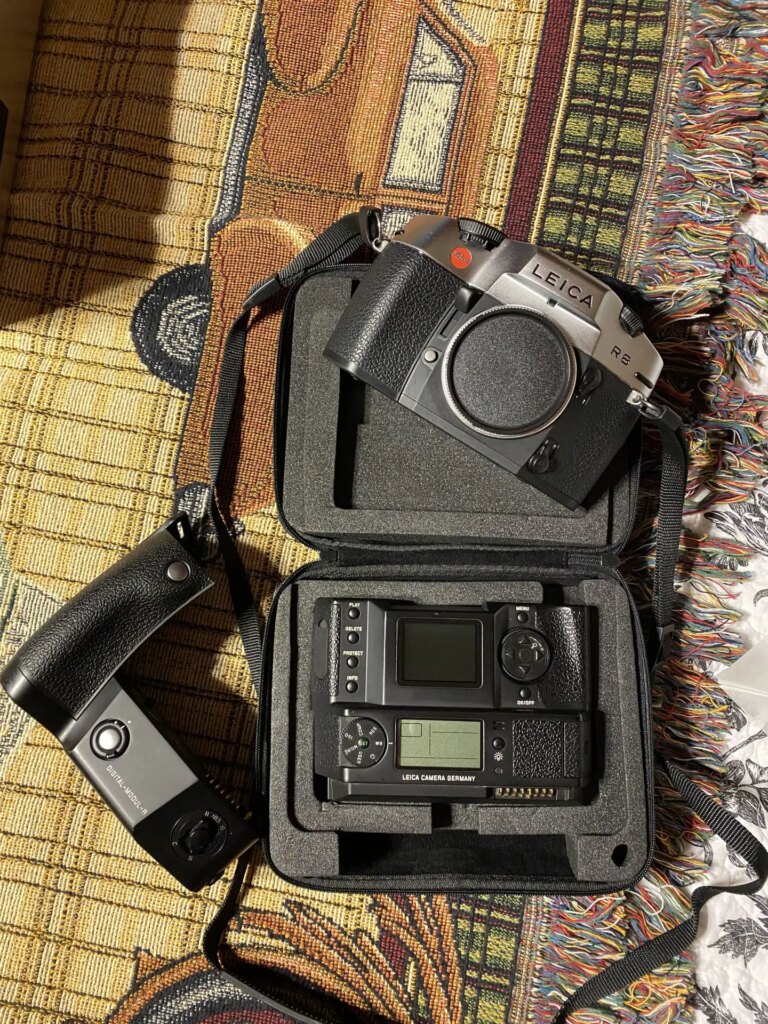
The Transformation
The Digital-Modul-R transforms the R8 into an entirely different beast. The transformation is effortless. Remove the grip as you would when replacing the batteries, open the film back and gently slide the hinge pin to remove the back. Then install the Digital-Modul-R back to the hinge point, remove the protective sensor cover, and close the back. Then attach the DMR grip making sure to line-up the contacts on the DMR. Insert the battery and now you have a digital SLR! It reminds the Hulk when it gets angry. This thing gets huge! Folks reviewing the standard R8 and complaining about how big and heavy it is need to look away now.
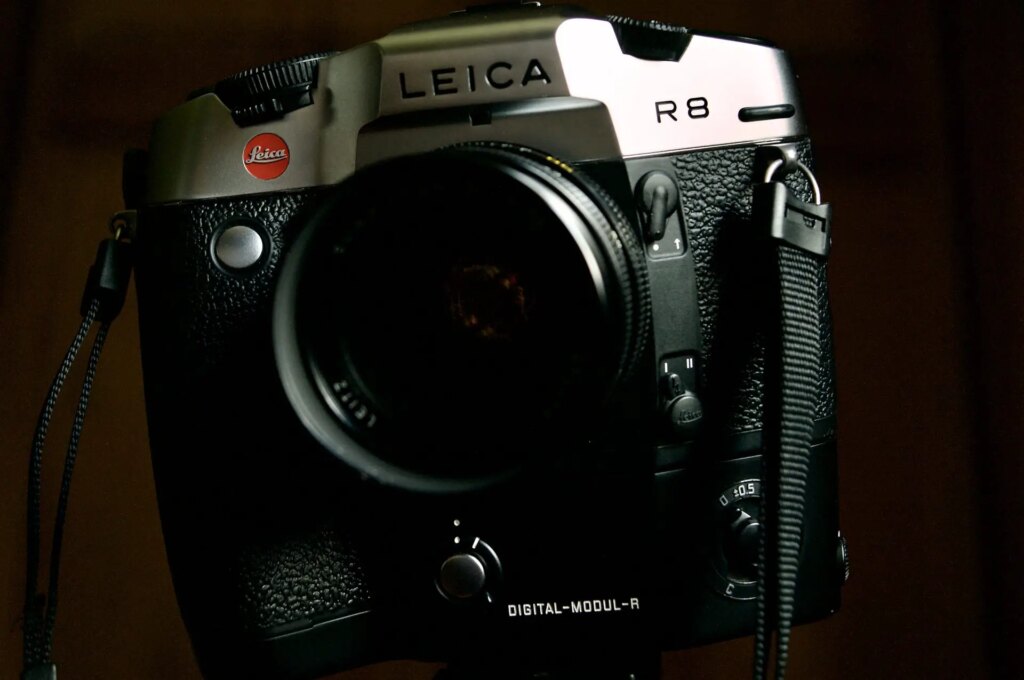
Let me throw in some comparisons. The closest camera in terms of size and weight to the Leica R8 with the Digital-Modul-R, and released one year prior to the DMR, is the Canon EOS-1D Mk II. Anyone familiar with using Canon’s flagships will now be able to comprehend the scale of this camera. How about something more modern? Leica’s own S3, a medium format DSLR, is two millimeters shorter, twenty millimeters narrower, nine millimeters thinner, and a whopping 355 grams lighter! The Leica with the Digital-Modul-R weighs about 1,615 grams. That is over 3.5 pounds! Imagine the four-pound bags of sugar available at the grocery store and carrying that around. That is the bulk of the Leica R8 DMR.
Despite the camera’s heft, its bulging form is a dream to hold. The grip fills your hand providing you a sucre yet relaxed hold. I do not feel the need to use a death-grip on this camera when carrying it around. When viewed from above, the wedge-like taper from the main grip on the right over to the left provides comfortable and unrestricted access to the lens and to controls. Very important considering this camera requires focussing to be done manually. This area provides a nice place to rest the camera on your right palm when holding the camera downward to review images. It is a minor detail, but one often overlooked by most brands. Pentax being the only one in recent memory to advertise a left-side grip. Leica also a leather hand strap to make the camera easier to hold securely in one hand.
One aspect that I love about the R8 is that every necessary control falls right where you would expect and need it to be. I particularly love the front-facing shutter release button on the Digital-Modul-R. I always liked the traditional placement of the standard shutter release button in the center of the shutter speed dial. It is a very logical and classically designed feature. With the added bulk and height of the DMR however, that button is quite a reach. So Leica, like with the Motor Drive attachment, added two shutter release buttons. The main one is on the front of the main grip and another lockable one on the bottom. The bottom one is convenient when photographing portraits. Even though it doesn’t look like it at first, the bottom shape is designed as a clever portrait grip. Grasping it naturally and resting your index finger in the divot sculpted along the inside of the main grip and triggering the shutter with your middle finger. Both shutter release buttons require only a gentle squeeze. I find this positioning to reduce camera shake when triggering. It is a design feature that will work great with larger and heavy lenses in particular.
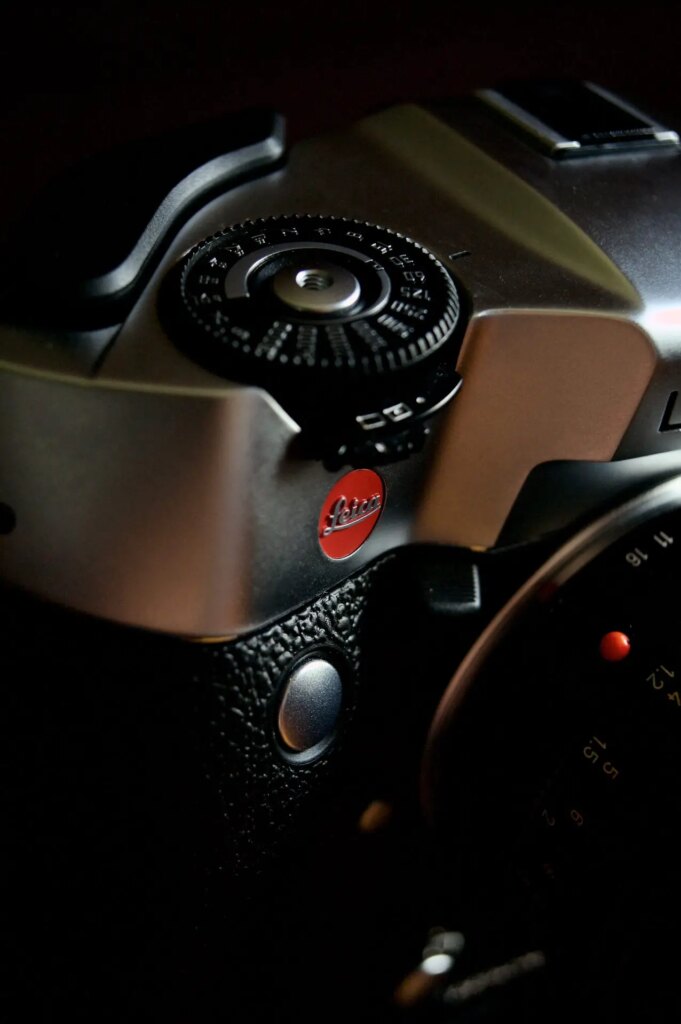
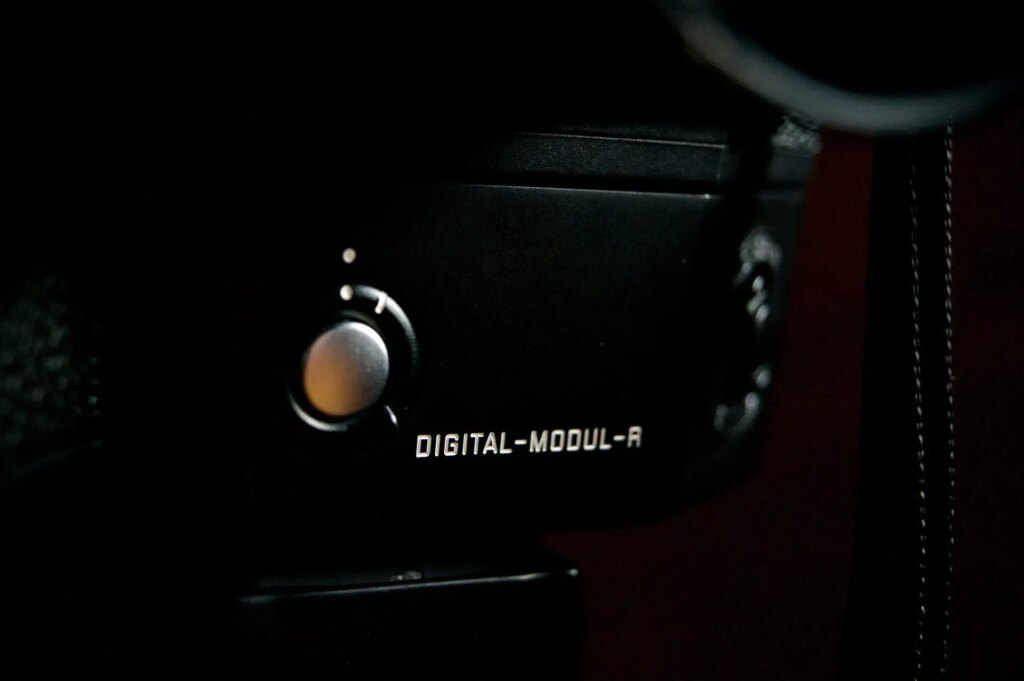
Another appreciated control is the metering mode selector switch. While this control is not exclusive to using the Digital-Modul-R, it is still a genius design. Located right below the shutter speed dial, this control is quick and easy to change when lighting conditions get tricky. I also admire the order in which the modes are arranged on the switch. Other brands organize these modes linearly with the evaluative or Matrix metering mode placed at one end or at the top of a menu. Leica places it in the middle position. Making it a home-base from which to easily move the selector left or right to select spot-metering or center-weighted (what Leica calls Integral Metering) respectively. Simple genius. Even if the metering mode was not shown in the viewfinder information display, (which it is) you can easily determine which metering mode is selected simply by feeling which position the switch is in. A great example of industrial design. A design that lets the camera get out of your way and let you focus more on capturing an image.
Control functions on the back of the Digital-Modul-R are mostly self explanatory. The only odd control is the one labeled “OK/OFF”. Pressing this button confirms selections when in menus. Pressing and holding the button turns off the DMR independently of the camera. This is unique to the R8 as the R9 had the proper connections to turn the DMR on and off with the main power/ mode dial on top.
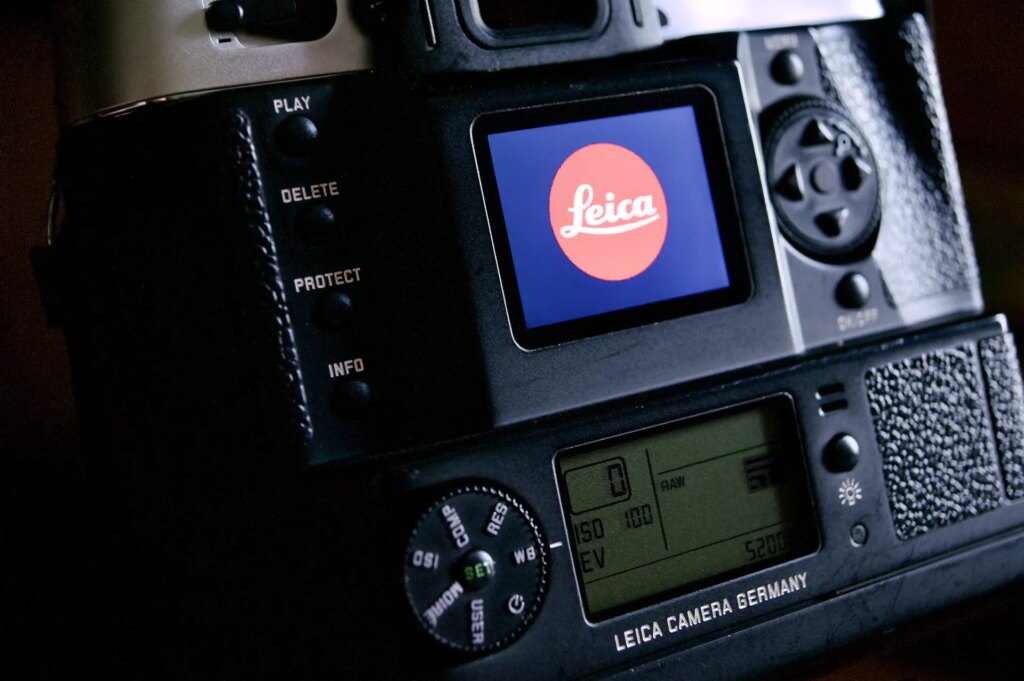
As with the rest of the R8 design, controls and operations are minimalistic and provide quick access to settings you need without a lot of frills. Most needed settings are located on the function settings dial in the lower left corner. Simply rotate the dial to the setting you wish to change, press and hold the SET button in the middle while rotating the command dial and watch the setting change on the lower LCD display. Simply release the SET button when finished and everything is set. It is that easy. No complicated button presses and standing on one foot while patting yourself on the head. Any users familiar with the likes of Minolta’s Maxxum 5 mode dial or Sony’s a100 function dial will understand this process easily. Realistically, the only settings I see using most are ISO, white balance, and sometimes the self-timer. The Compression and Moire settings are only available if you do not shoot RAW and I do not have any User settings saved. Every other key function you could need is already at your fingertips on the camera or lens body.
The Results
Everything considered, this camera provides the most “film-like” user experience and photographic results of any digital camera I have ever used. This includes other analog styled DSLRs like the Panasonic Lumix L1, which I hope to getting around to reviewing soon. The work that went into building the Digital-Modul-R to emulate film characteristics is phenomenal. You can shoot a roll of film, like Ektra or a favorite slide film, and then switch to the DMR and your images will look pretty similar. RAW images come out of camera with a rich, yet natural looking color palette. Sporting older technology, the DMR does not have as wide of a dynamic range and highlights can easily clip if you aren’t being mindful. Not a huge deal at all. Modern image editing software can also help recover some highlight data.
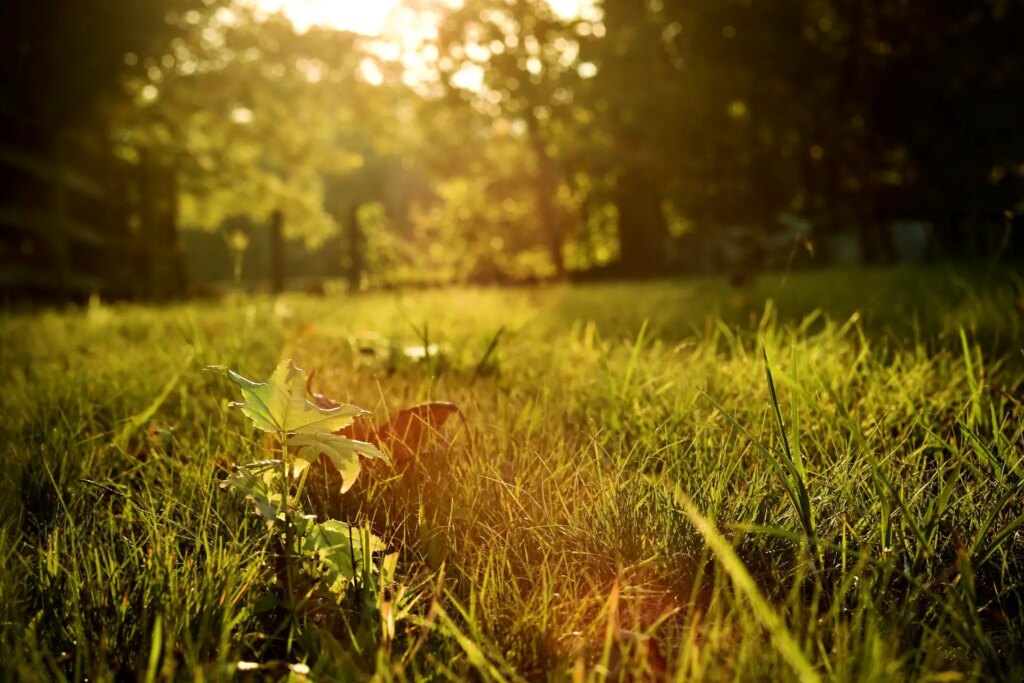

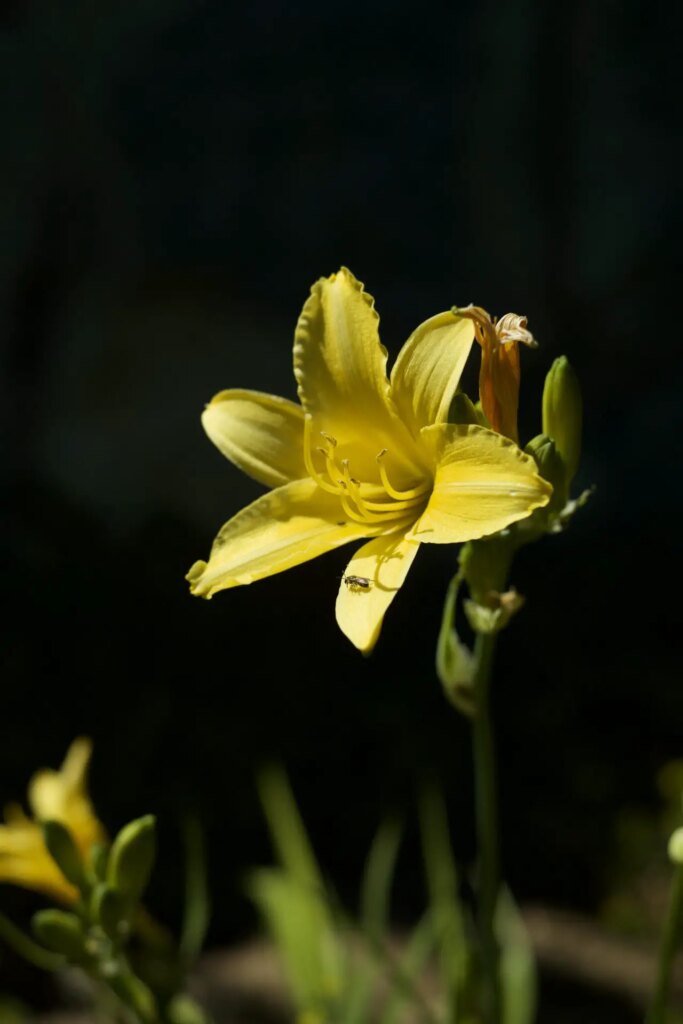
Like the camera itself, the size of image files from the Digital-Modul-R are much larger than you would expect for only being a 10 mega-pixel sensor. RAW files measure about 20.4 MB. Files from my Pentax K-7 only max out to about 18 MB. The K-7 being a slightly smaller, but higher resolution and much newer sensor I assumed it would provide a comparable file size. The SL (typ601) files are about double that of the DMR, which is to be expected. Still, I was shocked at how much information the DMR files had which lends them to being much more flexible in editing.
Sensitivity performance is very nice for a seventeen year-old digital sensor. The range is only from 100 to 800 (1600 available with ISO Push enabled in the menu). The images are not noise-free, but the noise does have a more organic appearance. Devoid of most of the ugly chroma noise common to cameras of this era. The Digital-Modul-R produces a film-like texture while still maintaining clarity within the image with minimal loss of detail. These high-ISO images are great to convert to black-and-white like with the parking deck entrance seen below. The texture becomes a character in the image providing an ambiance to the setting.
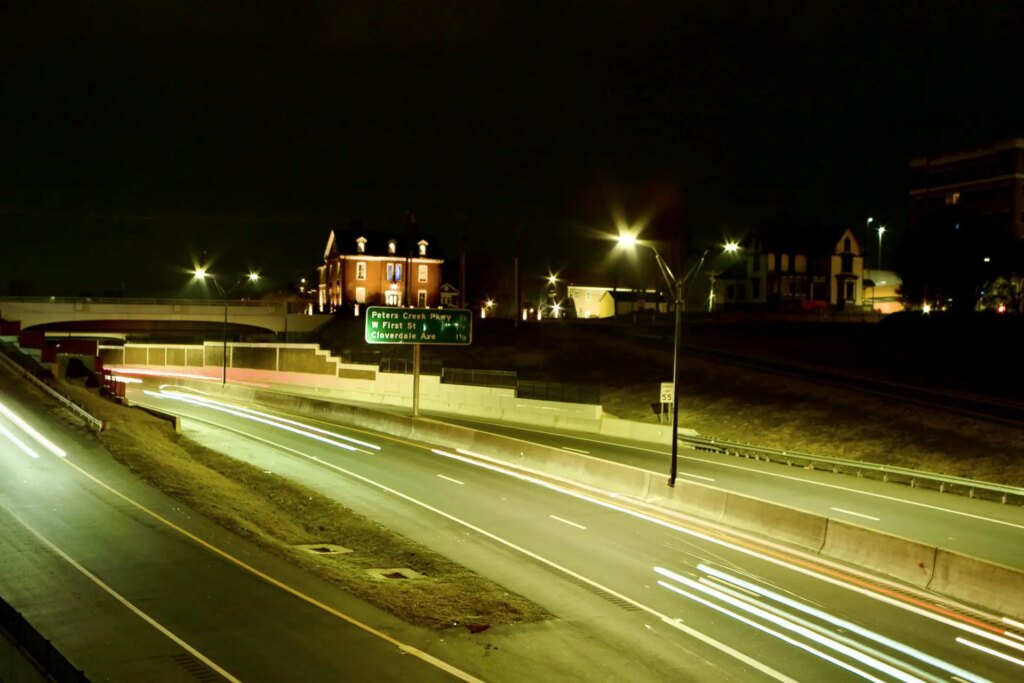
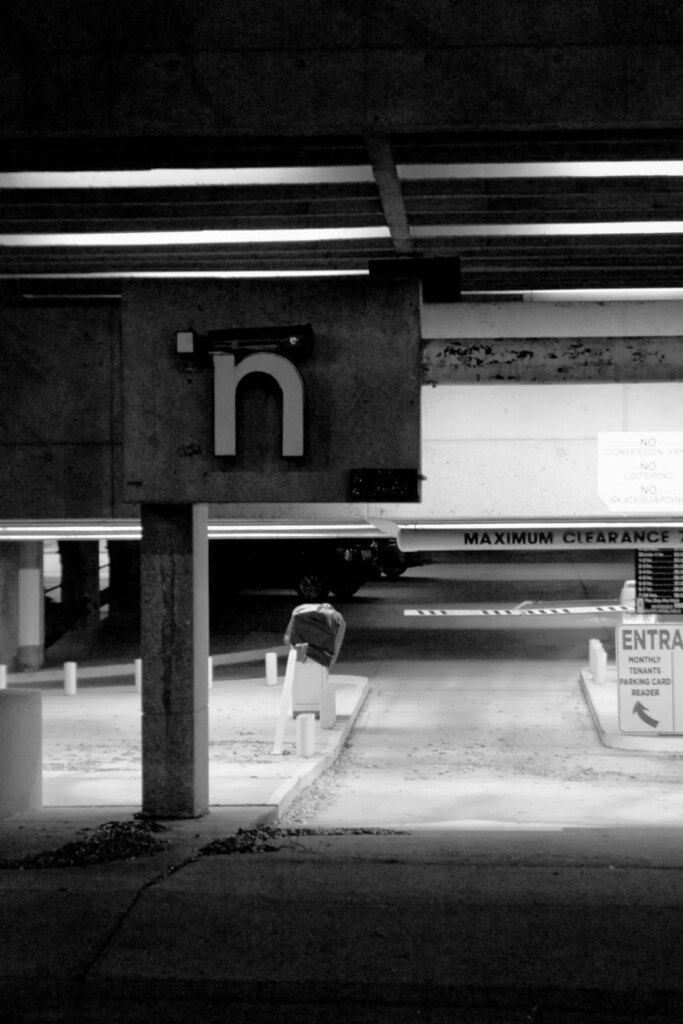

Up to this point I have been gushing nothing but praise for this camera and its ingenious digital conversion. However, we all know that every superman has his kryptonite. In this case the Digital-Modul-R’s is Lithium. Specifically the main battery pack. It is well documented online that the batteries on these have not aged well. Mine works well enough for the casual use that I give it, but even then I rarely fill the SD card before the battery dies. Worse still is the amount of discharge it experiences while sitting. I have to remember to charge if I intend on taking it out for any length of time. Since I have owned the DMR, using it more has restored some of the battery’s longevity.
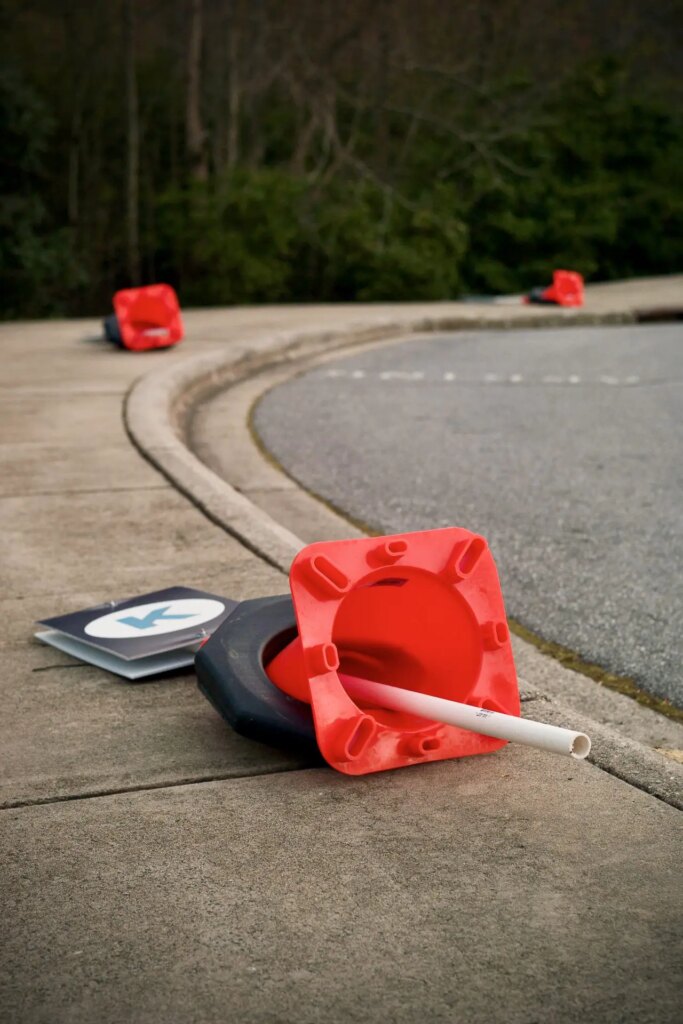
Other issues I find to be minor but are obvious when comparing to other DSLRs of the time and since. The rear screen for example is laughable. 1.8 inches and 130,338 pixels. The Panasonic L1 that I mentioned earlier was released a year after the Digital-Modul-R and has a 2.5 inch display at 207,000 pixels. Quite the size and resolution difference. It is not suitable to use to verify focus accuracy. It is surprisingly resilient to glare and shadowing when viewing it out in bright sun. It’s viewing angle, however, is not so impressive. Not surprising given the small screen size. Thankfully you do not have to rely on the rear display. Unless you have to dig into a menu, you don’t even require it all.
Although this was anticipated, another downer is that the sensor size is smaller than 35mm film. This lends a 1.37x crop factor similar to Canon’s APS-H sensor cameras. It is not a drastic crop for me and only becomes very obvious when wanting to shoot wide angle photos. Because of the crop, Leica supplies a replacement focusing screen that has frame lines so you can visualize the reduction in field-of-view. It is very nice in use. This effectively provides you a 100% viewfinder coverage. This implementation is reminiscent of a rangefinder view where you can see what is happening just outside of the frame while you are composing your shot. It is great when you are trying to anticipate action moving into the frame.
If there were one thing that I could wish for on the Digital-Modul-R it would be to have the option of disabling the motor advance. Many current DSLR cameras have a quiet mode where the camera is nearly or even completely silent. It would make for an awesome stealth camera to be able to trip the shutter and then wind the shutter manually. The thumb lever is there. Might as well make use of it as a feature with the DMR and it could have been ahead of its time.
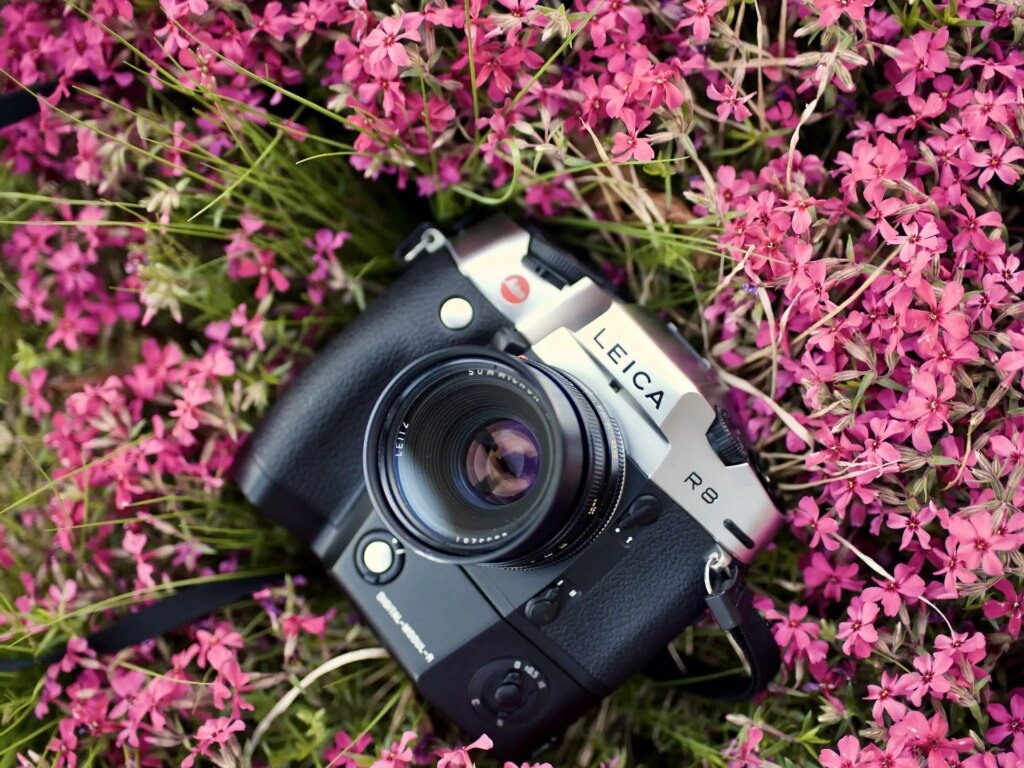
The Digital-Modul-R has long been criticized since its release as being too little too late for the brand. Swept aside by the rapidly changing market at the time, it was seen as an overpriced option that provided too-few modern conveniences to justify the exorbitance. Today the Digital-Modul-R is still expensive. Like all Leica products that I have encountered, this product is much more than its price tag. The DMR provides an experience unique to any other 35mm SLR. Sure there are numerous conversations of lenses and cameras to enable the use of R-series lenses on other camera bodies. But you can not convert those camera bodies easily from film to digital. The DMR is a unique and an exceptionally well conceived accessory to what can arguably be the most advanced manual-focus SLR every made.
Thank you for reading. Please check out more of my work at the links below. Until next time.
Jarrod Sams
Instagram @jrodsams
Share this post:
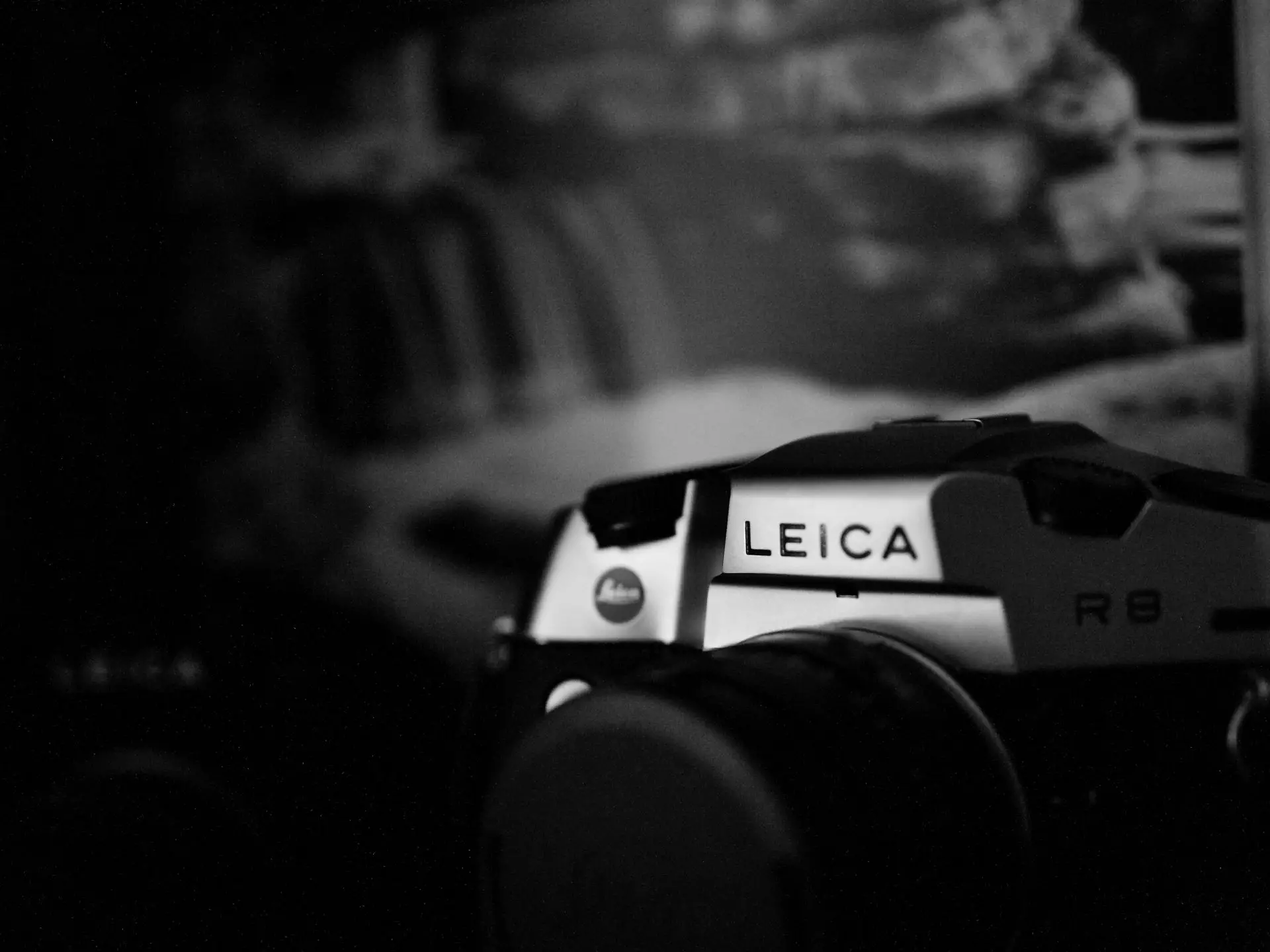
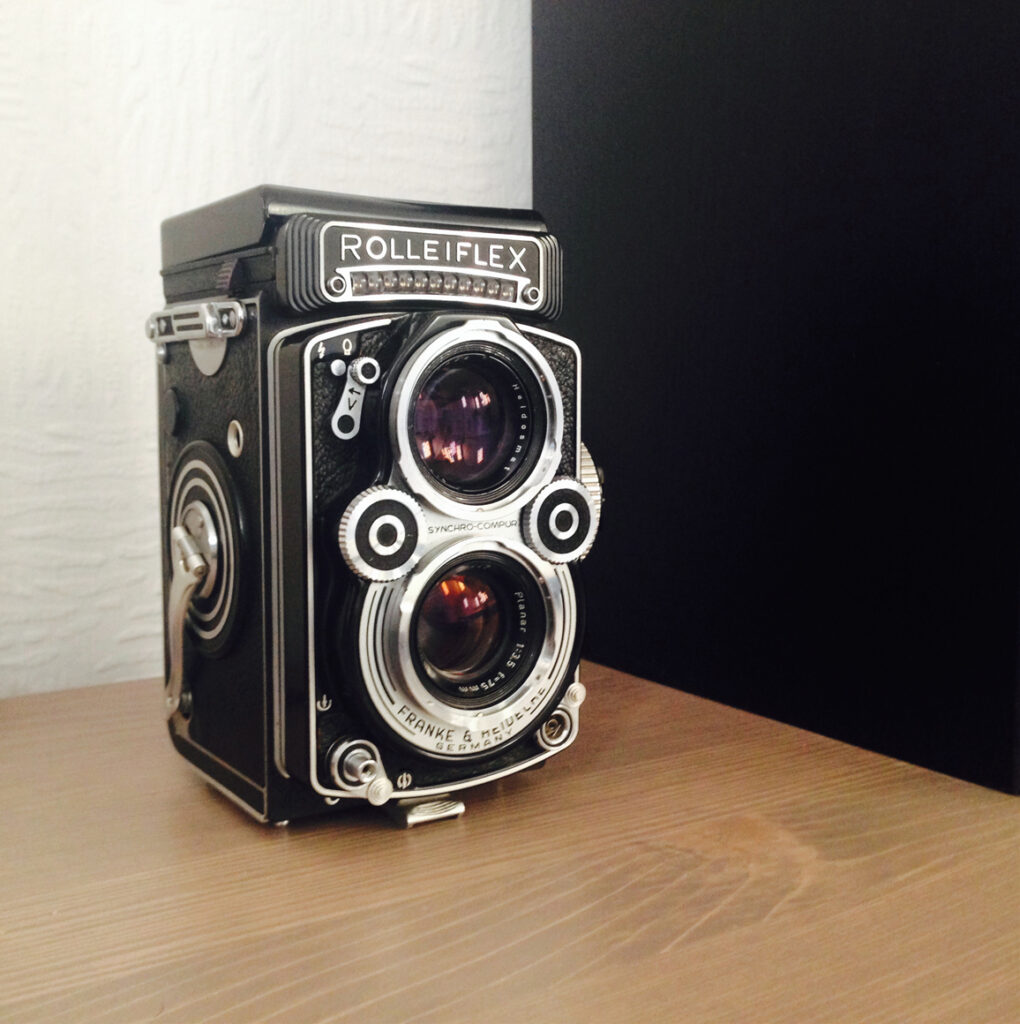
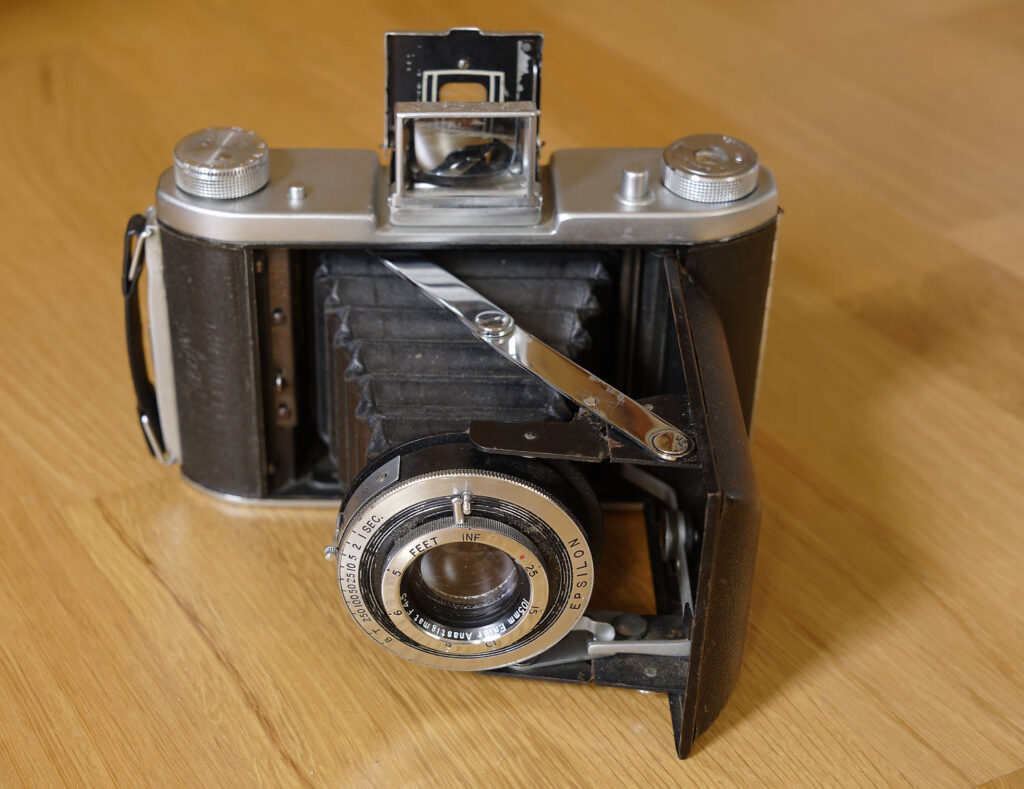

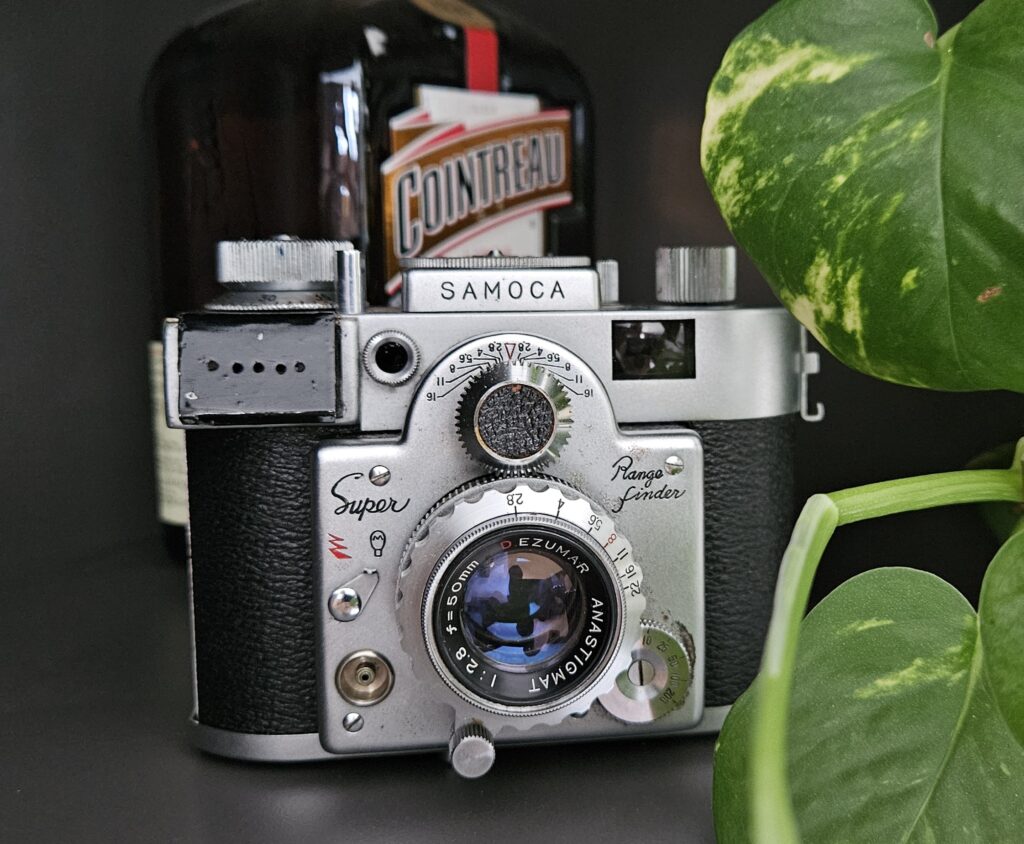




Comments
Jerrel on Leica Digital-Modul-R Review – ‘R’ You Ready for This? – My Passion Camera System – By Jarrod Sams
Comment posted: 08/08/2022
Comment posted: 08/08/2022
Comment posted: 08/08/2022
Nick Clayton on Leica Digital-Modul-R Review – ‘R’ You Ready for This? – My Passion Camera System – By Jarrod Sams
Comment posted: 08/08/2022
My sense is that the DMR was a precursor to the M8. I believe the sensor for the M8 was adapted from the DMR - both are 10MP 1.3x crop APS-H type CCD sensors. The image quality from both cameras is a lot better than expected, although the M8 doesn’t put out 20MP .dng files(!) Without much insight into the design process, the M8 feels like an M with an integrated digital back, so I believe these cameras are first cousins of sorts. I would love to try out your setup!
Comment posted: 08/08/2022
Kodachromeguy on Leica Digital-Modul-R Review – ‘R’ You Ready for This? – My Passion Camera System – By Jarrod Sams
Comment posted: 08/08/2022
Comment posted: 08/08/2022
Adam B on Leica Digital-Modul-R Review – ‘R’ You Ready for This? – My Passion Camera System – By Jarrod Sams
Comment posted: 09/08/2022
Comment posted: 09/08/2022
Eric on Leica Digital-Modul-R Review – ‘R’ You Ready for This? – My Passion Camera System – By Jarrod Sams
Comment posted: 12/08/2022
Comment posted: 12/08/2022
Technician on Leica Digital-Modul-R Review – ‘R’ You Ready for This? – My Passion Camera System – By Jarrod Sams
Comment posted: 19/08/2022
I mean, why users tend to stick to their Nikons? Why OTOH users often put on sale these esoteric and initially ultra-expensive reflex Leicas for the price that is affordable to your average film afficionado? Users just don't stick to R8/R9 cameras. And there's laundry list of valid reasons why, with the price on lenses being the least important of them. Trust me.
To put it bluntly: they are shit. Unreliable, quirky, unergonomical useless bricks. The design is polarizing to say the least. I genuinely enjoy the look of R8/R9. I really do. The camera is a looker. I like to put it on a table just to glaze at her, I like take photos of her (not with her). But the look is just a part of the overall design — and that's where ugly issues start surfacing up. First, the camera is gargantuan. Being 188 cm tall and having long fingers, I struggle to hold this brick with a firm grip. The way it sits into my palm induces tendonitis due to the strain the wrist is experiencing when I try to tighten the grip just not to let the body slip down to fall on the floor. Unacceptable. Manfred Meinzer didn't have the proper experience with cameras before hopping onto the endeavour of designing the camera system from scratch and it shows. There's the reason why the grip in various cameras has the same L-shape.
Next, R8 is unreliable. There were 4 unofficial revisions of electronics for R8 with the early copies being the least reliable and prone to various failures. I scored the R8 made in 2002 — the last year of production, having hopes for flawless experience and all I got is this: light leaks, inoperable frame counter showing "00" all the time, the issue with the rewind lever detaching from gearing to flip-flop freely like a banner in the wind, blank frames due to the mirror assembly failing to rise prior the exposure and quirky to use multi-exposure switch that induces the lever detachnig issue. Pardon my French, such a user experience does not belong in the portfolio of a superior camera brand. We're talking about new R8 in pristine condition, not about some worn and battered beater that's seen some rough shit in her life.
Being poor, I was dreaming of this camera for 10 years. I've been shooting with Canons, Nikons — mine or borrowed, but Leica R8 has been my "halo" camera for a decade. I slept with the dream of owning one someday. I had R8 on my computer's wallpaper. I've read all reviews in the Internet and Erwin Puts's "Compendium", where he describes all the benefits of the R-system. When I eventually got my dream realized, all I felt was sheer disappointment. It turned out I already had the best camera for me — the Nikon F5. Reliable, blazingly fast, convenient, heavy (to me it's a plus), tough — I can go on and on onto Nikon F5 topic. I prefer her to the F6 with MB-40 battery grip, because of smaller size.
So, folks, I hope my comment will serve as a cold shower for those, who consider buying the R8, especially with tempting prices on various selling boards. I've seen some beaters going for as low as $320. As it is usually the case, you should take with a pinch of salt all these glowing reviews on Leica brilliance, competence and other marketing bullshit, that is completely detached from reality. And reality is this: Japanese manufacturers are much more competent at engineering. German engineering is a myth. Ask BMW owners. Don't ask these posh Leica owners, though, they won't tell you the truth.
Comment posted: 19/08/2022
Comment posted: 19/08/2022
Keith on Leica Digital-Modul-R Review – ‘R’ You Ready for This? – My Passion Camera System – By Jarrod Sams
Comment posted: 02/09/2022
Comment posted: 02/09/2022
Duncan Kirkwood on Leica Digital-Modul-R Review – ‘R’ You Ready for This? – My Passion Camera System – By Jarrod Sams
Comment posted: 26/11/2022